Kalmys - the Game ([kal:mi:s])
Chronicler's Note: This is a 'live draft'. I am currently working actively on it and will be playing Grid O'Tails with my wife tomorrow, hopefully. This should help me spot flaws in the logic and fix them.Kalmys is a generic name for a wide variety of games based on the rolling of Kal-Cubes. While its original origins are unknown, the games are a regular part of the lives of the citizens of Qal'ath. Here, I, the Chronicler, will attempt to explain the variations I have witnessed - and occasionally partaken in.
The Meaning of 'Kalmys'
Despite having a Qalafoy name, the game has no origin within the Foyii. Evidence of this is its frequent use for gambling and drinking games, along with the lack of “language smoothing” rules in its name.
- Kal is derived from qal meaning 'a stone' or 'a small rock'
- Mys historically meant Elemental Attunement (per Myst Sensitivity but the common-folk, having only known the term be applied to Authorised Mages, morphed it into a word meaning "magical" or "lucky".
Alternative Names
Various names have evolved from the general idea of "making your own game from what you have". Also, alternative titles have emerged for different variations and/or intended players - one example being Kammy which is intended to be any variant that is played purely for enjoyment (such as children's or family games) and usually features an element of strategy rather than relying on the luck of the Cube and vaguely-intelligent guesswork. While the game's Variants have their own titles, alternatives to this "parent" name are:- Myska
- Kamys
- Kammy
Understanding the Kal-Cube
Before delving into the game's variants, please read up on the Kal-Cube, particularly the sections on:
- What is Kalmys?
- Who Played?
- A Cube May Not Be A Cube
- On Fairness (of the Cubes)
In Summary
A Kal-Cube may have five or six sides with more odd than even numbers. On a six-sided Cube, if the numbers 1-5 were used the sixth side was blank or defaced and would have to be rerolled. To play Kalmys is to embrace uncertainty, which also meant accepting your opponent's cube was likely not "fair".Game Variants
As I have travelled the Realm and beyond it I have seen a number of variants being played. These are the ones I can remember, though should the reader find a flaw in the rules, I am not above correction. It is possible this entry in the Bezélian Archives could be used in the future to encourage people to play, so accuracy is paramount.Bar vs Board
Please note: in the variations discussed, Quick-Play and Relaxed Play are classic Inn games, requiring no more than Kal-Cubes and maybe an empty tankard. Grid O'Tails (also known as Infiltration) and Blood Bath (or Vanishing Vanguards) are designed to be played with a grid or board and may feature pieces, making them more likely found in a home or other community setting.Variant 1: Quick-Play [Bar Game]
Aim
To roll an odd number, while your opponent rolls an even number or to bet on who will roll an even number.Type of Game
A bet or gamble dependant totally on chance. Note: Players with a five-sided Kal-Cube will need to ascertain if their opponent has a six-sided one and, if so, which variety. If their opponent's features a 7, then their odds of rolling an odd number will be higher than yours.Warning: Novices should insist on a maximum amount of coin for the session.
Playing
- Agree maximum bet of the round (or session).
- All bets are of equal value.
- Agree which of these rules to play: Longest Survivor, or Kind King (see below)
- Each player rolls a Kal-Cube.
Winners and Losers
- If both players roll an odd number, no coin changes hands.
- If both players roll even numbers, their bets should be set aside. A tankard (empty) should suffice.
- Outcome 1: If one player rolls an odd number, while their opponent rolls an even number, then the "odd" roller takes that round's bets. Tankard funds remain untouched.
- Outcome 2: If you're betting on who will roll an even number, Cubes must be rerolled until one shows an even number and the other an odd number.
It is generally acceptable for both players to bet the same way. In this case, if both are correct, then each retains their bet. If both players are wrong, place the bets in the Tankard.
End of the Game
If there is coin in the Tankard at the end of the game, the rule agreed in (1) is applied:- Longest Survivor: whoever won the most (in value of coin, or number of rounds) takes all from the Tankard.
- Kind King: Spend the Tankard on drinks for both players, or split the spoils evenly.
Variant 2: Relaxed Play (Bar Game)
Easy to play with two of the same type of Cube. Riskier, but potentially more fun with different Cubes (2/5 vs 2/6 chance).Aim
To guess which player will finish with an even number on a total of three rolls.- Players agree maximum coin to lose per round.
- Responsible players should declare a maximum amount for the whole game or evening
- If playing for fun only, any objects of a similar size and shape can be used as "coin".
Additional Components
A tankard, pot or plate to hold "coin" (real, or imaginary) not yet won. Never trust a person's "pocket" as a substitute. For clarity, the rules will refer to a "Tankard".Playing the Game
- Players take turns to roll the Cube twice. Add the two numbers together and declare it.
- Announce bet on who will finish on an even number.
- Players roll their Cubes together one last time. And the totals calculated.
Winners and Losers
Possible outcomes:- If you bet one way and were correct and your opponent bet the other way and was incorrect, you win that round's bets (Tankard funds included if relevant).
- If you both bet the same way and were correct, both players keep that round's bet. Tankard funds remain in the Tankard.
- If you both bet the same way and were incorrect, the bets are set aside (an empty tankard should suffice, hence the reference to “Tankard funds”) and added to the next round's bets.
Chronicler’s Note: This is a classic gambler’s game rather than just a lucky guess. People believe the chance of a “good” roll to be higher after two “bad” rolls, even though the probability is unchanged. That’s what sets this apart from Quick Play.
Grid O'Tails (Infiltration)
Two small squads of knights venture forth to claim their opponent's "fort".Aim
To completely occupy your opponent’s corner before they occupy yours. The overall winner is determined by who claims the most victories over four or more "rounds".Variants
There are two variants: Nothing to Chance and Chaos.Pieces Required
- 3 × Tokens per Player
- If playing "Chaos", using 2 × Kal-Cubes is encouraged.
- A 5×5 Grid with compass points on each corner, marked as: N(1), E(2), S(3), O(4)
- Optional: landscape obstacles: hills and/or trees.
Set-Up
Draw or turn your grid, so that players sits at opposite corners, one at Nùormà (N1) and the other at Sudà (S3). Player tokens start in their corner in a V-shape.Who Goes First?
While this matters very little, a simple roll of the same Kal-Cube with the highest roller going first. As we'll see, the overall "winner" is only determined after an even number of "rounds", to eliminate the "first turn advantage".
A classic Fyrikousii Kalmys board. This is the set-up for Grid O'Tails (both variants) before any landscape obstacles are added (optional).
An example of the placement of three landscape obstacles.
And a demonstration as to why three of them is probably too many.
And a demonstration as to why three of them is probably too many.
Optional: Landscape Items
No more than three landscape items should be used. Two can be challenging enough. To place landscape items randomly:- Initially place the landscape item in the centre. If an object already exists in that space, roll a Cube until a 2 or 4 is rolled and place the new one to towards Est, or Oest accordingly.
- Roll a Kal-Cube until 1, 2, 3 or 4 is rolled. This represents the edge of the board as follows:
1 = Nùormà to Est (North to East)
2 = Est to Sudà (East to South)
3 = Sudà to Oest (South to West)
4 = Oest to Nùormà (West to North) - Roll the Kal-Cube again and set the item that number of squares from that edge, or the last unoccupied space.
⇒ it is possible that the landscape obstacle may be placed next to a player’s starting tokens. If the subsequent ones do likewise, re-roll and re-place that one.
Playing "Nothing to Chance"
Currently reviewing whether this version makes it almost inevitable that the player who starts will also win.Apart from the setting of pieces, "Nothing to Chance" requires no more involvement of Kal-Cubes.
Role Playing
This game simulates a rush to take over an enemy fort as quickly as possible, with no battles. Therefore, no tokens are added or removed.Playing the Game
How to Move
Each player must move one token one place to an adjacent, vacant space. Moves along "compass lines" are not allowed. You may not move a knight directly from (N1) to (S3) or from (S3) to (N1). This rule applies to (E2) and (O4) also. In short, moves straight forward or to the side are disallowed Obstacles
All landscape items are considered obstacles so must be circumnavigated. Opponent tokens are also obstacles. A move must not prevent the opponent from moving. This will make winning as hard for you as them in "Nothing to Chance".
Each player must move one token one place to an adjacent, vacant space. Moves along "compass lines" are not allowed. You may not move a knight directly from (N1) to (S3) or from (S3) to (N1). This rule applies to (E2) and (O4) also. In short, moves straight forward or to the side are disallowed Obstacles
All landscape items are considered obstacles so must be circumnavigated. Opponent tokens are also obstacles. A move must not prevent the opponent from moving. This will make winning as hard for you as them in "Nothing to Chance".
Playing "Chaos"
As the name suggests, the "Chaos" variant can get messy!Pieces Required
The same as for Nothing to Chance, except with the addition of up to two Kal-Cubes.Role Playing
This game sees their squads of "knights" in a blind panic, being swept along by Chance and the Elements. There are still no "battles", so tokens are not added or removed from the board.Moving Your Pieces
The same restrictions over direction of movement apply as in Nothing to Chance.Playing the Game
Roll your Kal-Cube. If using a 6-sided Cube, you may use the “blank” to either not move, or to re-roll.
Note: If playing with two Cubes, only two “blanks” will permit a non-move turn. If a player does wish to reroll their blanks, both Cubes must be used.
If your totals are greater than zero, you must move the number of spaces on the Cube(s). For this reason, backwards moves are allowed and may even be necessary.
Moves may block an opponent token so long as they can "barge through" yours.
Obstacles and Barging
Landscape items are still obstacles. However, player tokens (including your own) may be "barged through" if there is not another token or obstacle on the opposite side of that player's token in the direction they’re barging. Barging counts as moving two squares unless it is that piece's final move of the turn.
Total Chaos
If you want to add to the chaos, either- ...move 2 tokens the total number rolled on the Cube(s), or
- ...roll one Cube and move one token, roll one Cube and move a different token.
Grid O'Tails Diagram
Here are the setup and rules in summary for Grid O'Tails (both variants). Landscape Obstacles/Items have been excluded for clarity, but their presence does not alter the rules demonstrated here.Blood Bath (Vanishing Vanguards)
Pieces Required
- 1 × Kal-Cube per player.
- A 5×5 grid as mentioned in Grid O'Tails.
- 6 × Tokens per player
- Optional: a landscape object representing "Scouts Hill", which should be placed at random per Kal-Cube rolls: 1: determines which side of the board to count from and 2: how many spaces to move and place it.
Chronicler's Note
I am still comparing notes from various taverns (please note that Byantea is my drink of choice) and homes of playing cultures. I will return to complete this entry when I have a working version.
Capture the Queen
Chronicler's Note
As I understand it, this is a variation on Blood Bath, where the game ends if the 'queen' is toppled or captured, averting unnecessary losses. Again, please bear with me, dear reader.
Footnotes
- "Taking a prisoner" (where one opponent's piece is held in your fort by two of your own) is futile as you cannot win a round unless all your pieces are in your opponent's fort. If a player refuses to move out of their fort, that round is forfeited and the winner is the player who had been taken "prisoner".


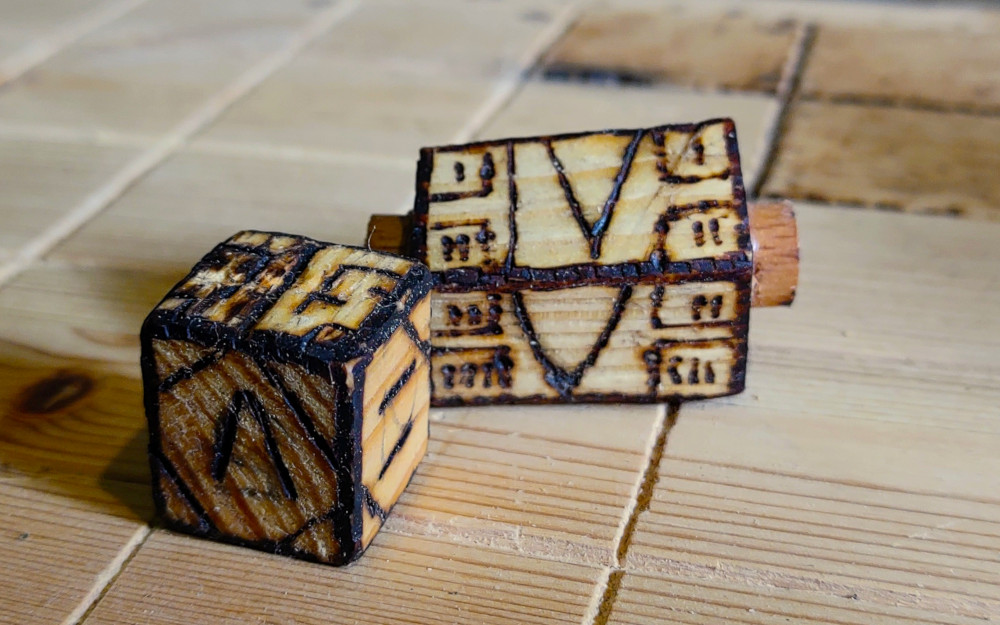
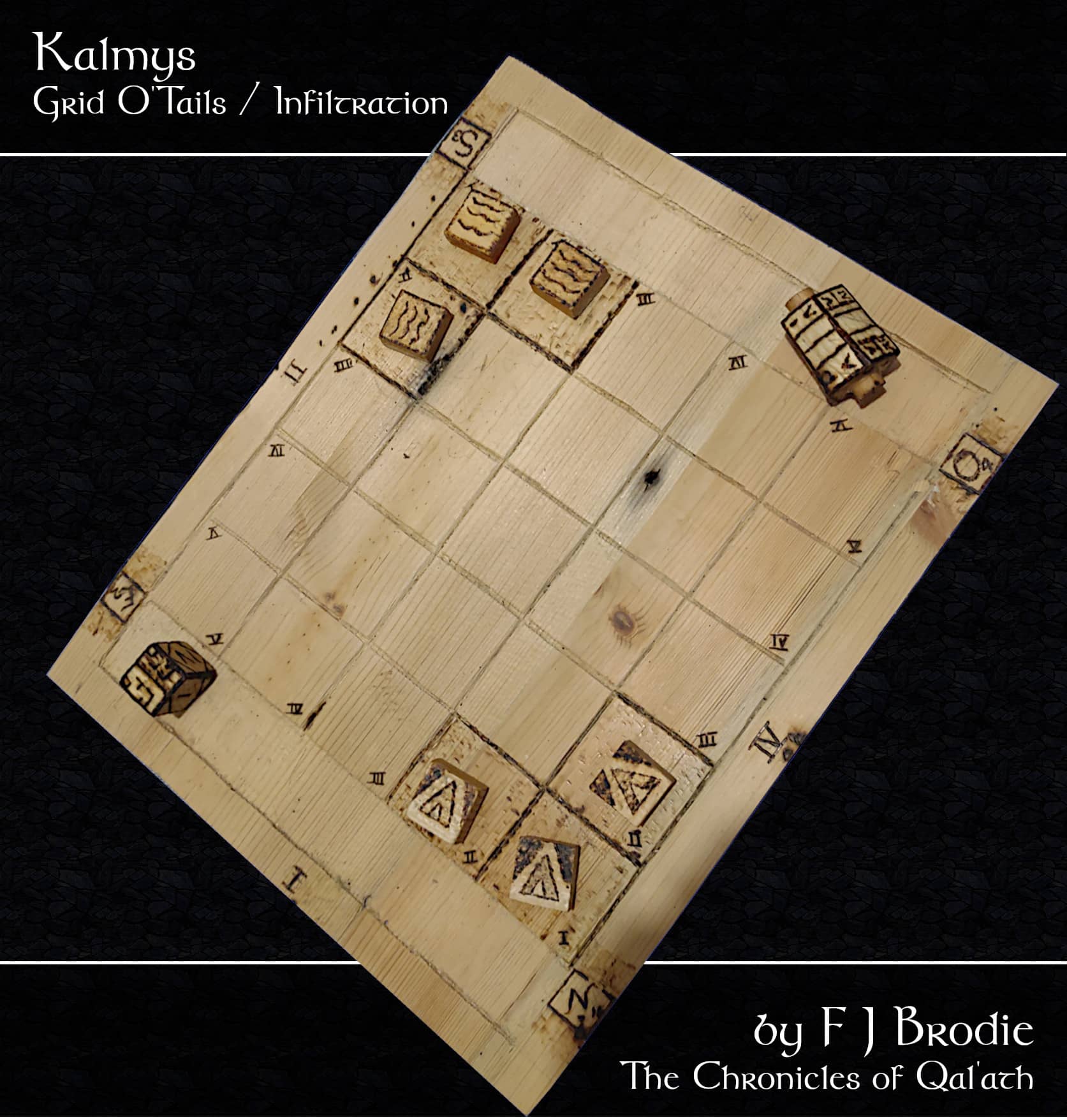
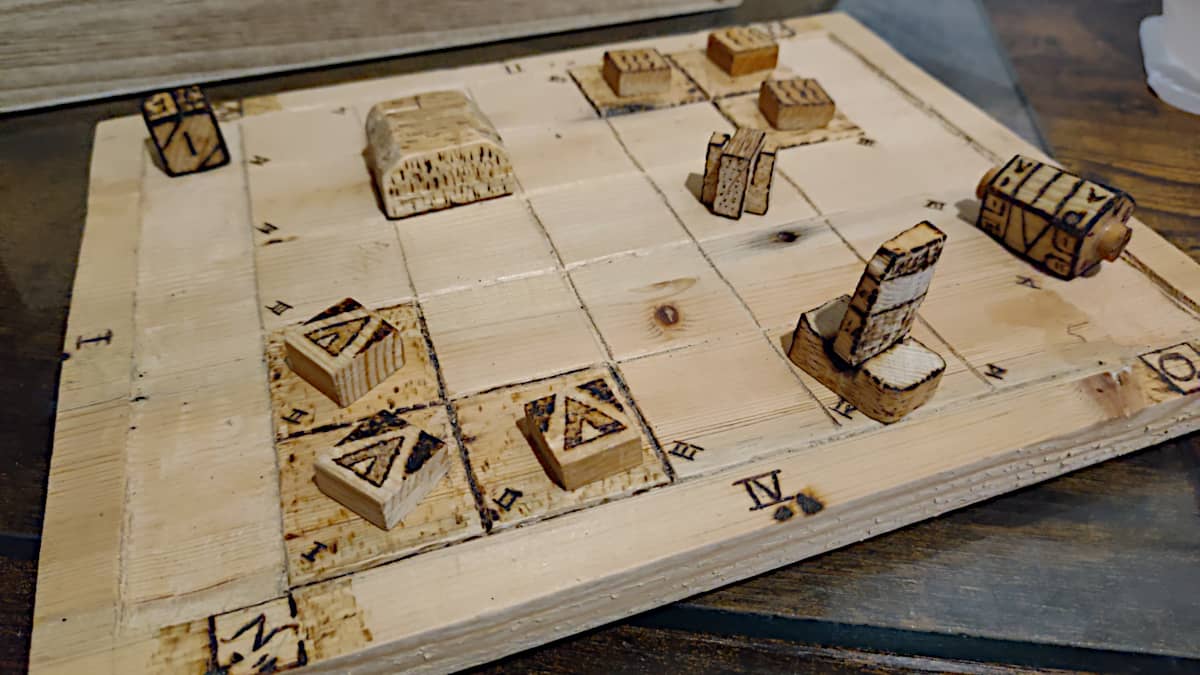
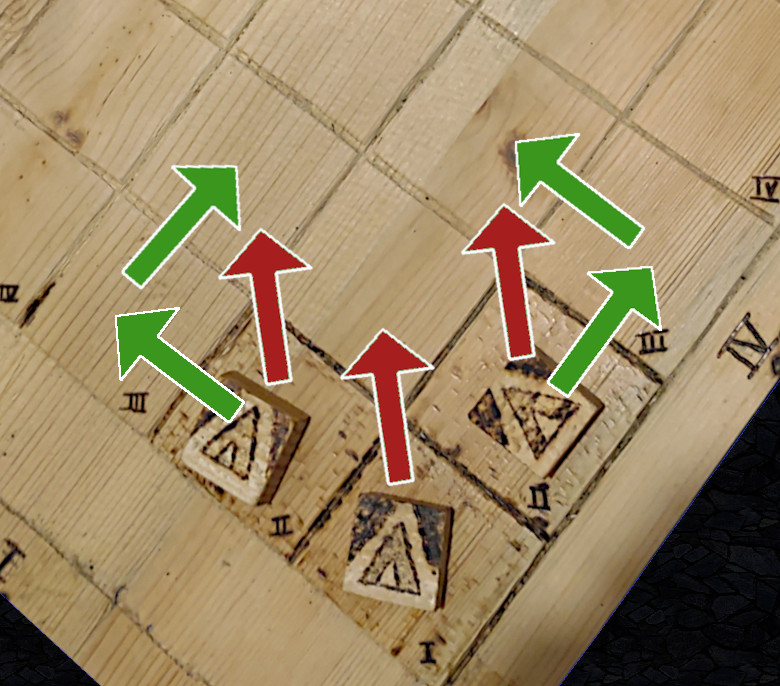
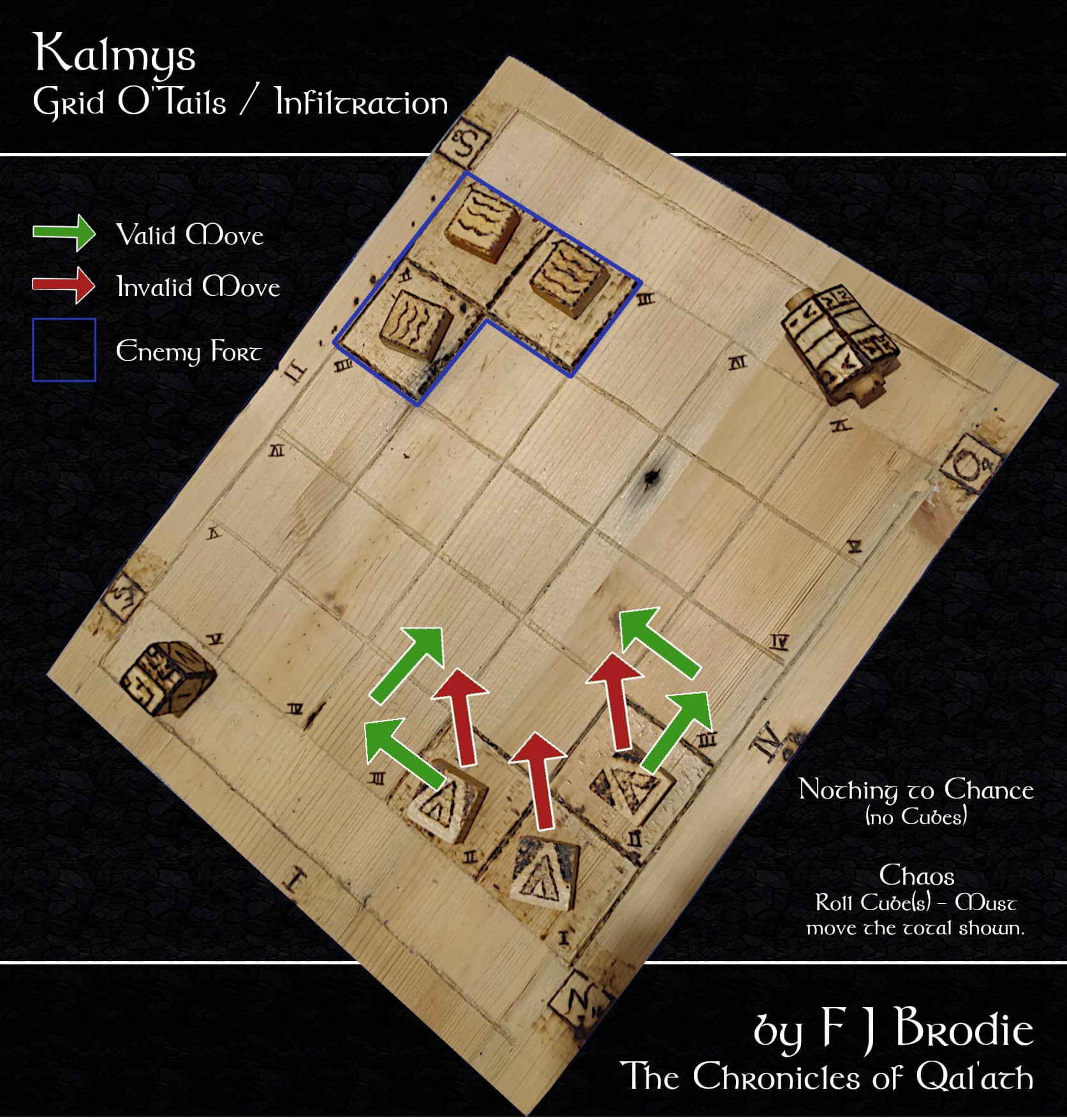



Comments